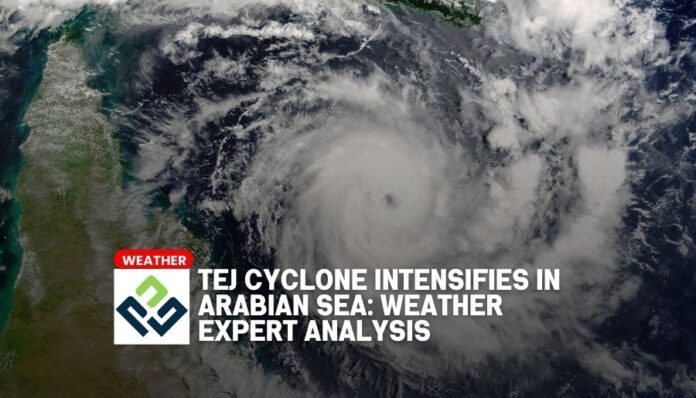Tej Cyclone Analysis
In the realm of meteorology, a significant cyclonic disturbance named Tej has emerged as a cause for concern. Originating in the Southwest Arabian Sea, this weather phenomenon has swiftly transformed into a Very Severe Cyclonic Storm (VSCS). According to data from the Pakistan Meteorological Department (PMD), Tej is currently positioned about 530 kilometers south-southeast of Salalah, Oman, at coordinates 12.5°N latitude and 55.2°E longitude. While the cyclone still maintains a considerable distance from the Pakistani coast, being approximately 1600 kilometers southwest of Gwadar and 1850 kilometers southwest of Karachi, its potential impact cannot be underestimated.
1. Powerful Characteristics
Tej exhibits a range of formidable characteristics. It is accompanied by maximum sustained surface winds, ranging from 150 to 160 kilometers per hour, and gusts that may reach up to 170 kilometers per hour. The sea conditions around the storm are nothing short of phenomenal, with a maximum wave height of 35 feet observed near the center of the system. These remarkable attributes can be attributed to the favorable environmental conditions Tej has encountered. Warm sea surface temperatures, low vertical wind shear, and a robust upper-level outflow have all contributed to its rapid intensification.
2. Expected Intensification
Forecasts indicate that Tej is far from reaching its peak intensity. In the hours to come, it is expected to further evolve into an Extremely Severe Cyclonic Storm (ESCS). The cyclone’s trajectory is unyielding, with its path directed northwestward, targeting the Yemen-Oman coast. While this is certainly a cause for concern in the region, the good news for Pakistan is that Tej is not anticipated to have a direct impact on any of its coastal areas. This forecast provides a collective sigh of relief for the residents and authorities of the country.
3. Nature’s Reminder
The intensification and movement of the Tej cyclone serves as a poignant reminder of the ever-unpredictable and dynamic nature of weather systems in the Arabian Sea. The elements that have fueled its rapid development are a testament to the intricate interplay of atmospheric conditions in the region. Meteorologists and weather experts are closely monitoring this storm’s progress, and it underscores the importance of advanced forecasting and preparedness in the face of such climatic events.
Conclusion
The emergence of the Very Severe Cyclonic Storm Tej in the Arabian Sea is a notable development that merits our attention. As it continues to intensify and chart its course, it provides an important case study for meteorologists and a reminder to all of us that nature’s forces are both awe-inspiring and unpredictable. The safety and well-being of the regions it may affect are of utmost importance, and continued vigilance in monitoring Tej’s progress remains crucial. Stay tuned for the latest updates as we track this powerful weather phenomenon.

